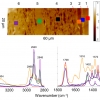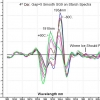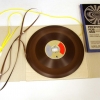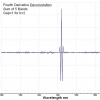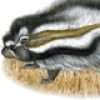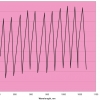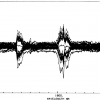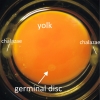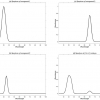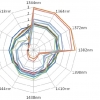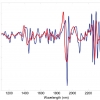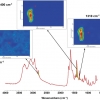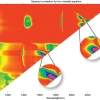Articles
Reverse engineering of polymeric multilayers using AFM-based nanoscale IR spectroscopy and thermal analysis
It is possible to obtain both infrared spectra and thermal analysis data of individual layers in a cross-sectioned multilayer film. Since both techniques are AFM-based, the topographical features can be readily linked to the spectroscopic and thermal data at a much higher spatial resolution than previously achievable.
Examining diffuse reflection and transmission spectra more thoroughly: Part 2. Sample temperature and sample composition
The Tony Davies Column once again contains a contribution from Karl Norris, who is widely regarded as the “father of NIR spectroscopy”. Karl continues to produce innovative ideas about the field and this article is no different. Building on the previous article concerning fourth derivatives, Karl has investigated the effect of varying gap sizes with some remarkable results.
ATR/FT-IR spectroscopy for the characterisation of magnetic tape materials
Do you remember magnetic tape-to-tape recorders and players? In any case, I am sure you will be interested in this article looking at the use of FT-IR spectroscopy to help the conservation of tapes in the collection of the National Museums Berlin. In “ATR/FT-IR spectroscopy for the characterisation of magnetic tape materials”, Elena Gómez-Sánchez, Simon Kunz and Stefan Simon describe how by investigating the state of the base layer of the tape, conservation efforts can be prioritised to those tapes in most immediate danger.
Examining diffuse reflection and transmission spectra more thoroughly: Part 1. Instrument noise
This Tony Davies Column is contributed by Karl Norris, known to many as “The father of near infrared spectroscopy”. He introduces his calculation method for fourth derivatives and shows how it can be used to extract instrument noise.
New broadband high-resolution ozone absorption cross-sections
With the threat of climate change, understanding the workings of our atmosphere is of crucial importance. Ozone is the most important trace gas in the stratosphere and troposphere and it is monitored by both satellite-borne and ground-based instruments. Accurate knowledge of ozone absorption cross-sections is vital for this work and described in this article.
The African crested rat's poisonous hairs studied by attenuated total reflection infrared spectroscopy
The African crested rat chews poisonous bark and then applies its saliva to specialised hairs which provide a most effective protection. Maxime Boulet-Audet and Chris Holland describe this and the use of infrared spectroscopy to learn more about this unusual animal. The new knowledge may even lead to new treatments for human cardiac conditions.
Evaluation of sensory and composition properties in young tea shoots and their estimation by near infrared spectroscopy and partial least squares techniques
Tea is harvested from the bud, the first leaf and the first three leaves up to a maximum of four leaves. Quality decreases from the bud down as the parts become older. This study looks at the use of NIR spectroscopy to determine optimal production using the harvested material.
Always look at the spectrum: Part 2. 3-D Normalisation
Tony (A.M.C.) Davies is again telling us to “Always look at the spectrum”. This time he uses an example from the development of a NIR spectrometer to demonstrate that one doesn’t really know what’s going on until one has “looked at the spectrum”.
Protein concentration prediction in cell cultures: the next stage in near infrared bioprocess analysis
This article shows that NIR spectroscopy offers the potential for bioprocess manufacturing companies to limit the variability in the biological production process, thereby increasing the yield and reducing the number of errors.
Near infrared spectroscopy in bioreactor performance monitoring
Anaerobic digestion is a good solution to the joint problems of dealing with organic waste and producing “clean” energy. However, running the digesters at optimum performace is a complex business. NIR spectroscopy offers a solution to monitor a number of analytes within the reactor and in real time.
Always look at the spectrum: Part 1. NIR noise spectra
Tony (A.M.C.) Davies stresses the importance of always looking at the spectrum, even if you [think you] know there’s nothing to learn. He relates his experience with noise in NIR spectra and what he has learnt from it. He would like us all to examine spectra for abnormality before relying on automated methods.
Near infrared spectroscopy of nanostructured materials
As nanotechnology grows in importance, the need for rapid, easy and automated analytical methods to investigate new nanomaterials increases. Near infrared (NIR) spectroscopy has the potential to replace numerous methods for the investigation of a wide range of nanostructured materials and with particular potential in the area of PAT.
Bird sexing by infrared spectroscopy
This article describes the analysis of cells from the pulp of the feather by IR spectroscopy and the possibility of using infrared imaging of intact eggs to determine bird gender.
A digression on regression
Tony Davies and Tom Fearn present “A digression on regression”. They turn their attention to one of the simpler regression techniques, Classical Least Squares (CLS). As well as an explanation of the basics, they explain why it is not often used in spectroscopy, and give the pros and cons of various regression techniques.
The role of microspectroscopy techniques in the study of historic artworks
Nati Salvadó, Salvador Butí and Trinitat Pradell have used a number of techniques to investigate changes in pictorial techniques in Catalan paintings in the 15th century. The combination of different techniques is of particular value. The use of synchtrotron radiation as a light source is also an advantage.
Aquaphotomics: Water in the biological and aqueous world scrutinised with invisible light
Roumiana Tsenkova introduces us to the field of “Aquaphotomics” which she has pioneered. The potential information held by water in biological systems coupled with NIR spectroscopy’s ability to extract a large amount of information at once, means that Aquaphotomics may be of great importance in the study of living organisms.
The use of near infrared spectroscopy to detect counterfeit medicines
The counterfeiting of medicines is an increasing world wide problem as a great danger to public health. Counterfeit medicines are imitations of their authentic counterparts so that both physical characterisation and chemical analysis are required to discriminate between them. In this respect, near infrared (NIR) spectroscopy is ideally suited to screening for counterfeit medicines because it is non-destructive, fast, requires no sample preparation, and provides a fingerprint of the physical and chemical composition of a product.
Revealing the presence of creatine in human spinal cord in amyotrophic lateral sclerosis, by infrared microspectroscopy
We have previously investigated the topographic and quantitative changes in the distribution of trace metals in spinal cords from ALS and control patients. X-ray fluorescence microscopy was used to investigate their metallic nature and distribution in single nerve cells. A deeper understanding of the neurodegenerative processes in ALS requires focus on the biochemical changes occurring in nervous tissue of such a disorder. For this purpose, we have undertaken an infrared microspectroscopy study. While metals are suggested to play a pivotal role in the pathogenesis of ALS, they typically do not occur in tissues as free ions. This results in the presence of the complex mechanisms of metal ions buffering that protect cells against their toxic effects. Metal homeostasis is regulated by several proteins. Such proteins containing metal cofactor are called metalloproteins.
The sound of science
I recently “discovered” a very interesting radio programme on BBC Radio 4. It is “devoted to the powerful, sometimes beautiful, often abused but ever ubiquitous world of numbers”. A few weeks ago we were asked to say what we were doing while listening to the programme. The next week we were told that nearly 2000 e-mails had been received and this data had been given to information designer David McCandless to turn into a graphic. When this was trailed I got the impression that something new and exciting was going to be displayed and I thought that the graphic would include sound. The graphic is good but rather “ordinary” and I was disappointed. This got me thinking about how we display information. Have we made any advance in the last 25 years? Could sound be used!
Interpretation of infrared and Raman spectra assisted by computational chemistry
<p>In last year’s <a href="https://www.spectroscopyeurope.com/td-column/and-now-something-completel...">August/September</a> issue of <em>Spectroscopy Europe</em> I wrote a column about my “discovery” of computational chemistry and asked if anyone was interested. A satisfying number of readers answered the on-line survey with very positive comments but none more so than Patrik Johansson who e-mailed me about his delight with the column and to assure me that there was “indeed a bunch of scientists out there that do work on IR (and Raman) using both experimental and computational techniques—I am one of them”! This column is the first result of the ensuing e-mail conversation and is due to Patrik. I remain excited by the possibilities of computational chemistry particularly as Patrik thinks that an approach to NIR spectroscopy is indeed possible.

